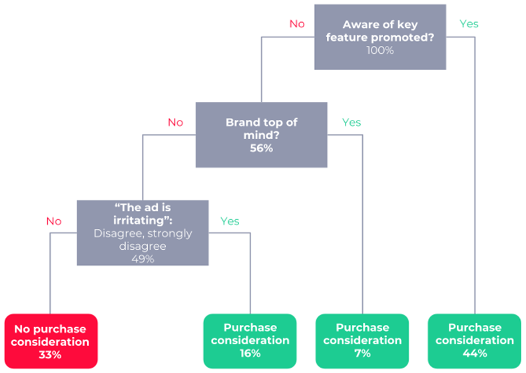The Path-to-Purchase, More of a Tree Than a Funnel
Many advertisers wisely use brand tracking and research to understand the lay of the land for their product - competitor market share, levels of consumer education, brand perception, levels of intent and the product attributes that could serve as levers for an effective market communication strategy. Underlying the framework of these trackers sits the revered marketing funnel. As we have moved to a world of ever more audience tailored messaging the question is - does the linear nature of "moving consumers through the funnel" hold? Often the data says otherwise.
The marketing funnel has given advertisers a framework for marketing strategy since 1898 when Elias St. Elmo Lewis first developed a theory on the customer's journey towards purchase. Whilst academics since have expanded and evolved thinking around the original model, Elias' original theory is largely still intact today. And why wouldn't it be - embedded in common sense, the notion that consumption of a service or product requires knowledge of its existence, what it does for you and some level of preference is fundamentally sound. But issues can arise in its tactical implementation through an implicit assumption. If you look at the average path to purchase of your product/service to develop your strategy rather than an array of user-centric paths, your tactics can similarly end up being overly linear.
Rather than looking at research data as a series of average stats we need to think about a form of analysis that captures the nuances of consumer journey to our desired action. Using classification analysis can help us visualize and understand the nonlinear relationship between the audience and these product attributes and be used to create a coherent, product and audience first communication strategy.
A classification output will give you a visual representation in the form of tree. The branches are split out by a set of rules that correspond to the various journeys towards your desired outcome. In this case these rules are based on messaging communication success and audience, the desired outcome is purchase consideration or intent. Higher accuracy levels can be hit with alternative modelling techniques but whilst it is worth validating with other models, classification analysis has a couple of major advantages for our purpose in that it is both highly interpretable and importantly, it doesn't assume a linear user journey.

Example CART analysis. n=609. Accuracy=84%
For this product respectful brand presence was needed or education of a particular key feature.
Generally when using this technique I have seen product vertical and audience based differences in the path to purchase:
- For entertainment the highest indicators in driving intent are communication messages that support interest - often increasing perception. In this vertical for younger audiences who aren't that interested in the ad itself, just showcasing an appealing attribute of the service (for example if they like the artist promoted) and being aware that the service exist is often enough for them to display intent.
- With Technology products the biggest focus should be on promoting relevance through features and understanding of the product - that is tell your audience what it is that actually makes the technology useful to them.
- CPG is the biggest outlier amongst these verticals. Here the audience is almost uninterested in understanding more about the product, likely due to the simplicity of the vertical. But very high levels of product appeal are enough in isolation to drive intent, suggesting emotional "feel good" ads may often serve you better here.
- Across product verticals younger audiences are often more likely to just try new products out indicating they may be easier pickings for winning market share. Advertisers may want to think about retention and loyalty based strategies for mature or less adventurous audiences.
So why not just use a good strategist to tell you all of the above? Well please do, intuition and experience are indeed a solid basis for hypotheses on what might work. But what research based classification analysis can do is robustly support this with numbers - what message supports understanding of your tech product, what emotional drivers invoke product appeal for CPG commodities and which artist will make people want to try out your entertainment service. Just as vertical strategy varies in all of the above, many product specific outliers exist. You might have tech products with enviable brand loyalty or CPG products which are new to market and require greater levels of product understanding.
In summary whilst commonality of successful tactics exists and can guide us, every product is deserving of its own unique communication strategy. Each meriting not a funnel, but its very own tree.
